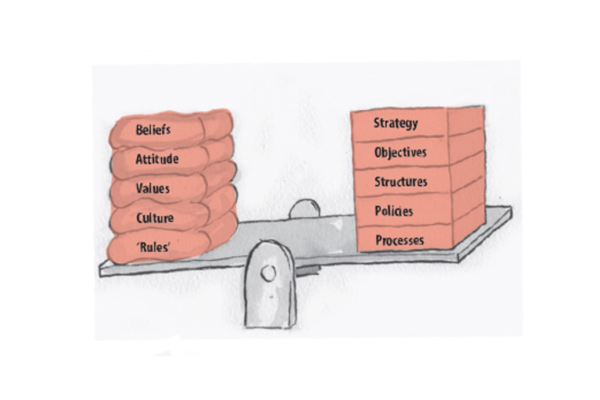Is there a disconnect between your company initiatives and team morale? You’ve restructured, spent on branding, defined company values – yet the spark still seems absent. Here are some familiar frustrations:
- “I’ve restructured the team, but they still aren’t motivated.”
- “We’ve invested in new branding, but people still don’t feel engaged.”
- “We updated company values, but poor behaviour hasn’t changed.”
So, what’s missing? As a founder or leader of a scaling organisation, you’ve probably shifted much of your focus to big-picture management. You’ve invested in leadership training and implemented new processes, but despite these efforts, the buzz just isn’t happening. Why does this gap persist, and how do you bridge it effectively?
Jeff’s story: changing everything but the mindset
Consider Jeff, a senior director in a global property company. His team had been acquired from another company, expected to transition to the new culture without major changes to staff or location. On paper, everything was set up for success: new management structures, updated contracts, even regular meetings. Yet Jeff found himself frustrated by the team’s lack of enthusiasm.
He confessed to me, “I’m at my wits’ end. We changed their terms, put them on the bonus scheme, updated their screensavers – but still there’s no spark. What more can I do?” Jeff had taken all the structural steps expected of him.
I suggested he consider the emotional impact of the change. He paused, thought a bit, then replied, “Do you think it would help if we put them in a uniform?”
Jeff’s approach was typical. He’d prioritised structural solutions because that’s what he knew best. With a background in concrete management skills – data, restructuring, organising – he defaulted to solutions that were visible and easily measurable. Yet the human side of change – the emotional needs, concerns, and aspirations of his new team – wasn’t part of his plan.
The missing element: emotional buy-in
When people are uprooted from one company culture to another, they need more than new contracts and team meetings to feel engaged. They need a safe space to voice their concerns, express their excitement or apprehensions, and adjust to their new surroundings. Jeff’s team wasn’t resistant to change, but they needed support to find their footing.
People are often more comfortable discussing these changes with peers than with their new leader. Jeff’s team probably discussed their feelings among themselves but lacked an intentional outlet for communicating with their leaders. Without this, they were more inclined to put on a brave face and keep their heads down than to feel truly connected and inspired.
Balancing the tangible with the intangible
Managing an organisation effectively requires a two-pronged approach: addressing tangible structures and systems, as well as less obviously tangible elements like culture, attitudes, and behaviours. Look at the diagram above.
On the right are concrete systems like strategy, structures, policies and processes. You will often instinctively recognise and tackle these because they’re both measurable and critical for your organisation’s stability.
On the left are elements like values, beliefs, behaviours, and attitudes – areas that are harder to quantify but equally important. Leaders sometimes overlook these because they don’t produce immediate, concrete outcomes.
While management of the tangible factors keeps your organisation running, management of the less tangible factors shapes the culture and energy of the team. Leaders like Jeff often don’t prioritise the latter until they cause visible issues, which is when many turn to experts for help in repairing broken relationships or dysfunctional teams.
How to drive real engagement
To unlock the ‘buzz’ in your culture, you must embrace the softer skills alongside the hard. Here’s how to get started:
1. Move beyond structural solutions
Real engagement doesn’t come from systems alone. Your efforts with contracts, bonuses, and systems are necessary, but they don’t address what your team really needs. People seek meaning, connection, and a sense of belonging: create space for team members to discuss the emotional and social impact of change.
2. Foster open communication
Instead of top-down directives, introduce a culture where feedback flows openly in all directions. Jeff’s team needed a channel to voice their anxieties and hopes about the shift. By creating regular opportunities for genuine conversations and feedback, you can build trust and foster a collaborative spirit. Remember, communication isn’t just an item on a checklist – it’s the foundation of a cohesive team.
3. Culture is a core responsibility
Culture is the “how” behind your organisation’s “what.” While practical measures are critical, culture is built through values and attitudes expressed in day-to-day interactions. As a leader, you are accountable for shaping and maintaining a culture that supports your vision. By actively managing it, you’ll reduce friction, build resilience, and cultivate a sense of shared purpose.
4. Prioritise people skills
You need listening, empathy, and clear communication to create an environment where people feel valued and connected. Instead of managing the fallout from poor engagement, invest in building these skills for yourself and your team now. You will find that small adjustments in how you interact with and support people make a huge impact on overall engagement.
5. Build an empowering environment
Leadership isn’t about controlling every detail but about empowering people to find fulfilment in their roles. Give your team room to innovate, explore, and take ownership of their work. Encourage collaboration and celebrate their successes as part of a collective effort.
A holistic approach to leadership
For leaders like Jeff, recognising that structural changes only address half of the equation is a turning point. Addressing both tangible and intangible needs doesn’t require complex techniques but a shift in mindset: to see your role as both strategist and custodian of your organisation’s culture.
In your scaling organisation, fostering an engaged, motivated team is your greatest asset. Technical expertise and structural know-how may build the framework, but it’s the human connection that fuels growth and drives meaningful change.
